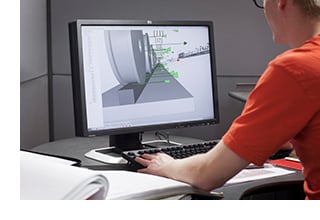Industry-leading rail analysis
 If your crane is experiencing excessive wear on wheels and rails, has broken wheel flanges, or you’re frequently replacing bridge couplings and axles – you may need to take a deeper look at rail alignment.
If your crane is experiencing excessive wear on wheels and rails, has broken wheel flanges, or you’re frequently replacing bridge couplings and axles – you may need to take a deeper look at rail alignment.
The RailQ Runway Survey has been designed to deliver accurate information on the alignment of your crane rail and expert recommendations for any needed corrective actions.
Is your crane traveling correctly on the runway?
Cranes should travel or track along their runway rails with a minimum of skew and without binding. Improper tracking leads to premature wheel and rail wear, resulting in costly repairs and downtime, as well as inefficient and suboptimal crane operation.
There are many reasons why a crane does not travel correctly on the runway:
- Rail may be misaligned or worn
- Clips may be missing
- Pads may be worn
- Runway structure is uneven, bent or twisted due to column settlement, overloads or impacts
- Corrosion
- Improper installation
Improper tracking is normally investigated by performing a traditional runway survey. However, these surveys may result in days of costly downtime, and the results may not be accurate or clear and may not offer corrective actions.
RailQ uses a remotely operated robot to minimize downtime and increase the safety of the survey. It provides information on runway span, straightness, elevation and rail-to-rail elevation.
What’s included in a RailQ Runway Survey?
RailQ can be performed on virtually any runway including those for overhead cranes, port cranes and woodyard cranes. The runway survey includes:
- A visual inspection of the crane runway
- Measurement of the alignment of your crane runway.
- Calculations based on measured data with proprietary analysis and visualization software
- 3D and 2D visualizations of the runway rails
- Identification of straightness, span or elevation issues
Konecranes engineers review all collected data and provide recommendations for corrective actions.
 The CraneQ Crane Geometric Survey works together with the RailQ Runway Survey to give you a complete view of crane and rail geometry.
The CraneQ Crane Geometric Survey works together with the RailQ Runway Survey to give you a complete view of crane and rail geometry. 
